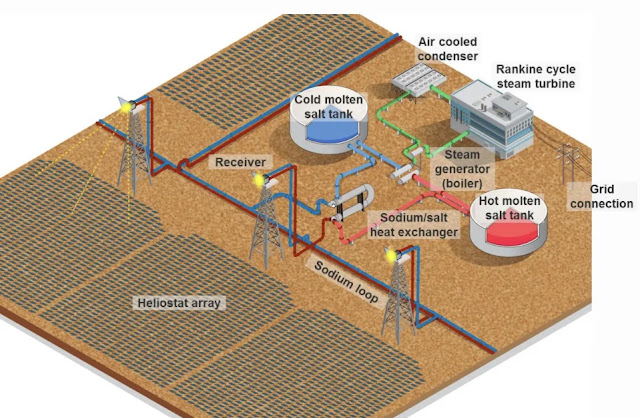A few years ago, concentrated solar power (CSP) looked as if it was going to be an immensely valuable resource to increase the share of renewables in the grid.
CSP used mirrors to concentrate the rays of the sun on a central "receiver" which got so hot it melted sodium salts. These molten salts (at ±600 C) could be used immediately to boil water to create steam and drive conventional turbines to generate electricity, or they could be stored to be used later, typically overnight. The molten salts in their special reservoirs lost heat very slowly, so could be stored for days or even weeks.
The cost of the CSP power station lay mostly in the mirror array and the receiver, not the storage, so adding storage was much cheaper than adding storage via batteries to solar panels is. In principle, CSP could provide baseload power more cheaply than coal and much more cheaply than nuclear. The only problem was ..... the storage tanks kept on cracking, leaking the molten salts and reducing or stopping output. And so, the CSP dream ended.
Except it didn't.
An Australian company, Vast Solar, developed storage tanks which were flexible enough not to crack, with a modular system which allowed bigger CSP plants. I talked about it before, here.
Well, Vast Solar is going from strength to strength. It's being listed on the NYSE, and has expanded its development pipeline to 3700 MW, with 230 MW of projects under development.
Now that the technology works efficiently, the potential to scale is dramatic. The total addressable market for CSP by 2050 will be between 700 and 1,800 gigawatts (GW), with a revenue potential of over $3.5 trillion, according to a top tier international management consulting firm. The International Energy Agency (IEA) forecasts deployment of up to 430 GW of new CSP capacity globally by 2050 for on-grid applications alone.
That leaves room for many players to succeed but Vast Solar is a first mover [and owns the copyright to the flexible tanks] – and [is] already getting a piece of the pie. The company has 230 megawatts of projects under development, with a total pipeline of 3.7 GW, as of February 2023.
Large governments around the world are firmly backing the business. Up to A$ 215 million of funding has been committed by the Australian and German governments.
Importantly, the technology is tried and true, with CSP v3.0 already piloted for over five years and de-risked through a grid-synchronized demonstration plant that’s operated for nearly three years. The modular tower modality and sodium-based heat transfer technology provide a design that increases reliability and efficiency, while reducing complexity, cost and construction time.
To accelerate deployments in the US, the Inflation Reduction Act (IRA) is expected to materially improve project economics through the 30+% investment tax credit. The partnership between NETC and Vast Solar represents an attractive entry point for some of the most topical energy transition macro themes: dispatchable power, storage, process heat and green fuels.
Traditional storage solutions come with many compromises such as cost, safety and supply chain issues. CSP offers a variety of key features, including carbon-free, dispatchable power and heat, lower cost technology for sun-belt countries, highly efficient systems with minimal losses, integrated energy storage with thermal batteries that charge themselves with daylight, and a low-risk supply chain consisting primarily of glass and steel.
CSP solves two problems that wind and solar photovoltaics (PV) cannot. Wind and solar PV are intermittent generators. Adding battery storage allows wind and solar PV to be dispatched, but only with limited duration, at a high cost and with significant trade-offs. CSP provides efficient long-duration storage which makes it comparable to traditional fossil generation.
Decarbonizing manufacturing is challenging because many industrial processes require heat that can only be efficiently generated by burning fossil fuels. CSP can generate process heat equivalent to burning fossil fuels, allowing manufacturers to decarbonize.
Vast’s Modular Tower is a new and innovative approach to CSP that seeks to address the challenges facing conventional CSP. The Modular Tower utilizes molten sodium as its heat transfer fluid, which enables a modular tower design that unlocks benefits that collectively drive down costs and de-risk the operation.
These provide a variety of advantages, including reduced construction time, locational flexibility, lower operational risk through better thermal process control, higher operating temperatures delivering improved plant economics in both salt storage and turbine efficiency, and the ability to alter dispatch to meet changes in grid circumstances.
Additionally, modular towers offer a safer and cheaper way to conduct maintenance on a smaller tower and receiver, increasing the ability to meet customer requirements for both power and heat.
Turning to deployment goals, the company has a focus on several sunny regions, including stretches of North America, Europe/Middle East, APAC, Latin America, Central and South America, and Africa.
One proof point is Vast Solar’s 50-megawatt Mount Isa solar thermal plant, located in northern Queensland state, which is also a testament to the growing demand for renewable energy. The isolated mining community will benefit from the plant, which incorporates technology that allows heat from the sun to be stored for up to 16 hours.
[From Yahoo!Finance]
Because CSP enables longer storage than batteries, it will play a key part in the renewable grid, and it will reduce the need for gas peaking. The grid of the future will have wind, solar, CSP, and other lesser sources of green electricity (micro hydro, wave power, tidal power). The greater the variety of generation sources, the more stable the output.


No comments:
Post a Comment